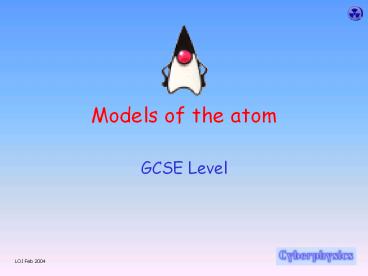Models of the atom - PowerPoint PPT Presentation
Title:
Models of the atom
Description:
Models of the atom GCSE Level The atom The atoms are listed in the periodic table. What do you know about the atom ? What have you been taught about it? – PowerPoint PPT presentation
Number of Views:97
Avg rating:3.0/5.0
Title: Models of the atom
1
Models of the atom
- GCSE Level
2
(No Transcript)
3
The atom
- The atoms are listed in the periodic table.
- What do you know about the atom?
- What have you been taught about it?
4
Current model of the atom
5
You need to know
- In a neutral atom, the number of electrons is
equal to the number of protons in the nucleus.
The atom as a whole has no electrical charge. - The number of protons determines which element
you are dealing with - The number of neutrons determines which isotope
of the element you are dealing with.
6
Plum Pudding Model
7
Plum Pudding Model
- JJ Thomsons model was sensible!
- They knew that electrons were tiny specks that
could be removed from atoms so they were seen
as tiny plums in a large plum pudding. - The whole atom was thought of as a positive
sphere embedded with negative electrons just as a
plum pudding was embedded with plums. - This was the pre - 1911 understanding of what the
atom was like!
8
(No Transcript)
9
Rutherfords Experiment
- The plum pudding atom indicated that the atom
was made of smeared out positive charge with
concentrated specks of negative charge embedded
in it - So if you fired alpha particles at it you
expected them to go straight through - Any slight change in trajectory would indicate
how the charge gradient altered within the sphere
- Was it getting gradually more dense towards the
centre? Or was it denser around the edge like a
shell? How was the charge distributed? - In 1911 Rutherford hoped to find out!
10
Rutherfords Experiment
- His findings astounded him!
- The fact that the vast majority of the alpha
particles got straight through led Rutherford to
propose that the atom was composed primarily of
empty space.
11
Rutherfords Experiment
- The fact that backscattering occurred in 1 in
8000 alpha particles indicated that the nucleus
in the centre was - small (that was why so few were affected)
- massive (meaning containing lots of mass - he
knew the electrons had very little mass and the
fact that all of the positive charges were
concentrated into a small area meant that the
mass was concentrated there too) - positively charged (because it repelled the alpha
particles)
12
Why did his new model become so widely accepted?
- Because it was backed up by experimental
evidence! - It wasnt common sense but the evidence showed
it was true! - Others were able to repeat the experiment and
find this out for themselves - So the old model was replaced by the new one
13
- The proton number Z (or atomic number) indicates
the element to which the atom belongs - All atoms of a particular element X have the
same number of protons. Atoms of different
elements have different numbers of protons. - The total number of protons and neutrons
(nucleons) in an atom is called its nucleon
number A.































